towing CITROEN DS3 CABRIO DAG 2015 Handbook (in English)
[x] Cancel search | Manufacturer: CITROEN, Model Year: 2015, Model line: DS3 CABRIO DAG, Model: CITROEN DS3 CABRIO DAG 2015Pages: 404, PDF Size: 13.93 MB
Page 86 of 404
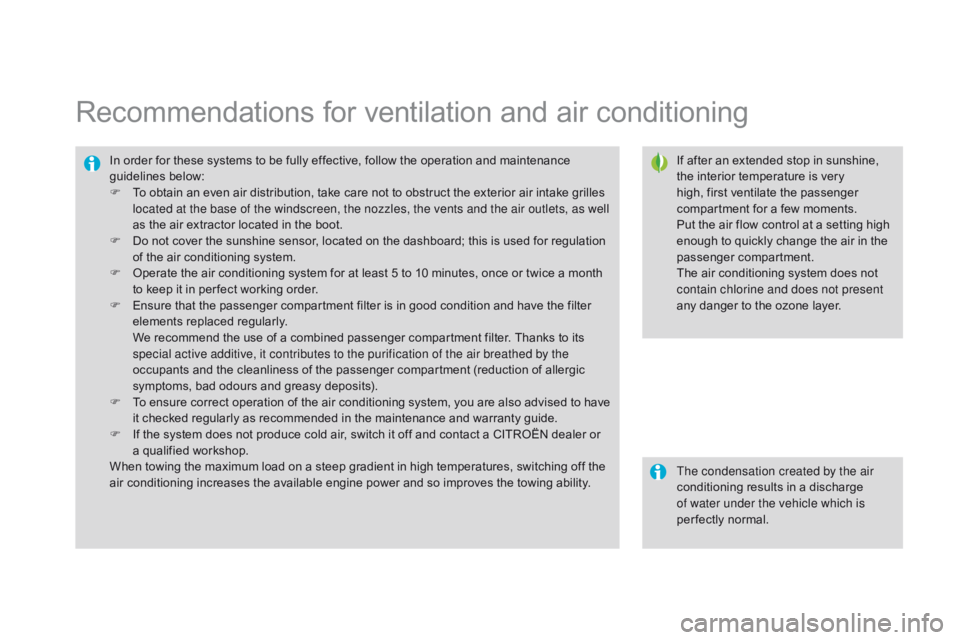
DS3_en_Chap04_confort_ed01-2014
Recommendations for ventilation and air conditioning
If after an extended stop in sunshine, the interior temperature is very
h
igh, first ventilate the passenger
c
ompartment for a few moments.
Put
the air flow control at a setting high
e
nough to quickly change the air in the
p
assenger
c
ompartment.
The
air conditioning system does not
c
ontain chlorine and does not present
any
danger to the ozone layer.
In
order
for
these
systems
to
be
fully
effective,
follow
the
operation
and
maintenance
g
uidelines belo
w:
F
T
o
obtain
an
even
air
distribution,
take
care
not
to
obstruct
the
exterior
air
intake
grilles
l
ocated at the base of the windscreen, the nozzles, the vents and the air outlets, as well
as
the
air
extractor
located
in
the
boot.
F
D
o
not
cover
the
sunshine
sensor,
located
on
the
dashboard;
this
is
used
for
regulation
o
f
the
air
conditioning
system.
F
O
perate
the
air
conditioning
system
for
at
least
5
to
10
minutes,
once
or
twice
a
month
t
o
keep
it
in
per fect
working
order.
F
E
nsure
that
the
passenger
compartment
filter
is
in
good
condition
and
have
the
filter
e
lements
replaced
regularly.
W
e
recommend
the
use
of
a
combined
passenger
compartment
filter.
Thanks
to
its
s
pecial active additive, it contributes to the purification of the air breathed by the
occupants
and
the
cleanliness
of
the
passenger
compartment
(reduction
of
allergic
s
ymptoms,
bad
odours
and
greasy
deposits).
F
T
o
ensure
correct
operation
of
the
air
conditioning
system,
you
are
also
advised
to
have
i
t
checked
regularly
as
recommended
in
the
maintenance
and
warranty
guide.
F
I
f
the
system
does
not
produce
cold
air,
switch
it
off
and
contact
a
CITROËN
dealer
or
a
qualified
workshop.
When
towing
the
maximum
load
on
a
steep
gradient
in
high
temperatures,
switching
off
the
a
ir
conditioning
increases
the
available
engine
power
and
so
improves
the
towing
ability. The condensation created by the air
conditioning
results in a discharge
o
f water under the vehicle which is
per fectly
normal.
Page 104 of 404
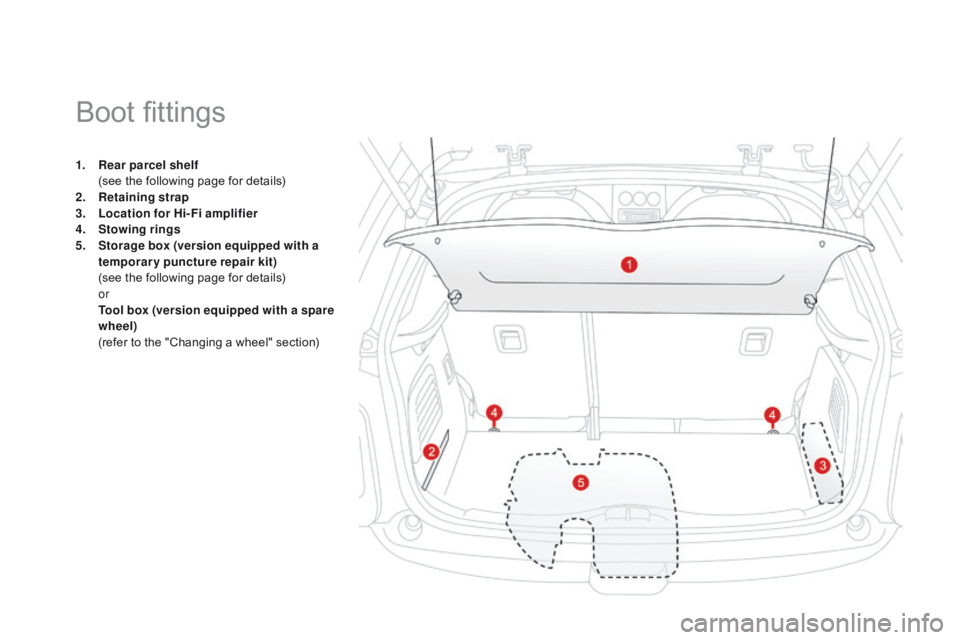
DS3_en_Chap05_amenagement_ed01
1. Rear parcel shelf (
see the following page for details)
2.
R
etaining strap
3.
L
ocation for Hi-Fi amplifier
4.
S
towing rings
5.
S
torage box (version equipped with a
temporary puncture repair kit)
(
see the following page for details)
or
T
ool box (version equipped with a spare
wheel)
(
refer to the "Changing a wheel" section)
Boot fittings
Page 129 of 404
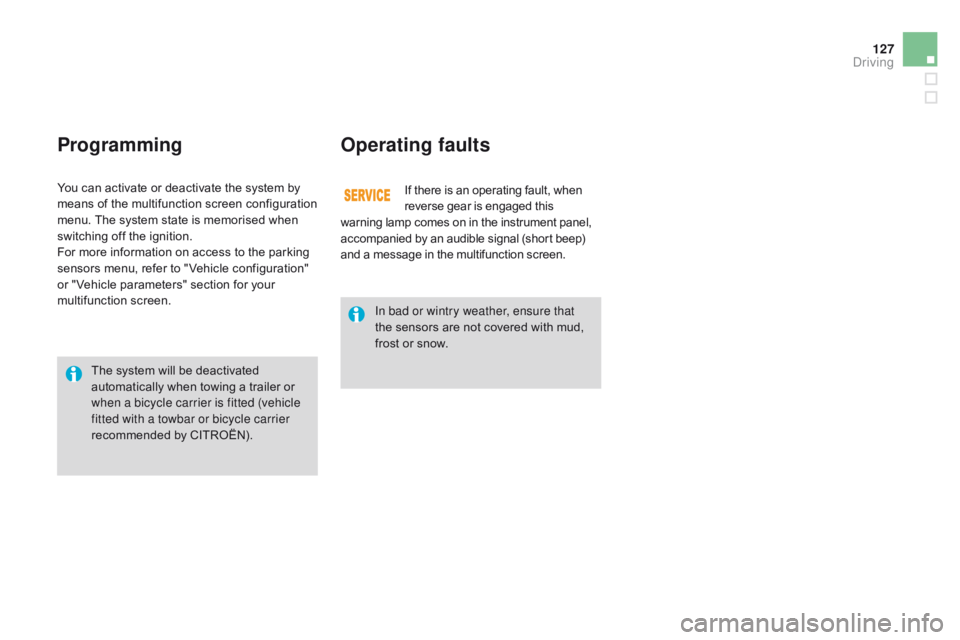
127
DS3_en_Chap06_conduite_ed01-2014
ProgrammingOperating faults
If there is an operating fault, when r
everse gear is engaged this w
arning
lamp comes on in the instrument panel,
a
ccompanied by an audible signal (short beep)
a
nd
a
message in the multifunction screen.
You
can
activate
or
deactivate
the
system
by
m
eans
of
the
multifunction
screen
configuration
m
enu.
The
system
state
is
memorised
when
s
witching
off
the
ignition.
For
more
information
on
access
to
the
parking
s
ensors
menu,
refer
to
" Vehicle
configuration"
o
r
" Vehicle
parameters"
section
for
your
m
ultifunction
s
creen.
The
system
will
be
deactivated
a
utomatically
when
towing
a
trailer
or
w
hen a bicycle carrier is fitted (vehicle
fitted with a towbar or bicycle carrier
recommended
by
CITROËN). In bad or wintry weather, ensure that
the
sensors are not covered with mud,
f
rost
or snow.
driving
Page 150 of 404
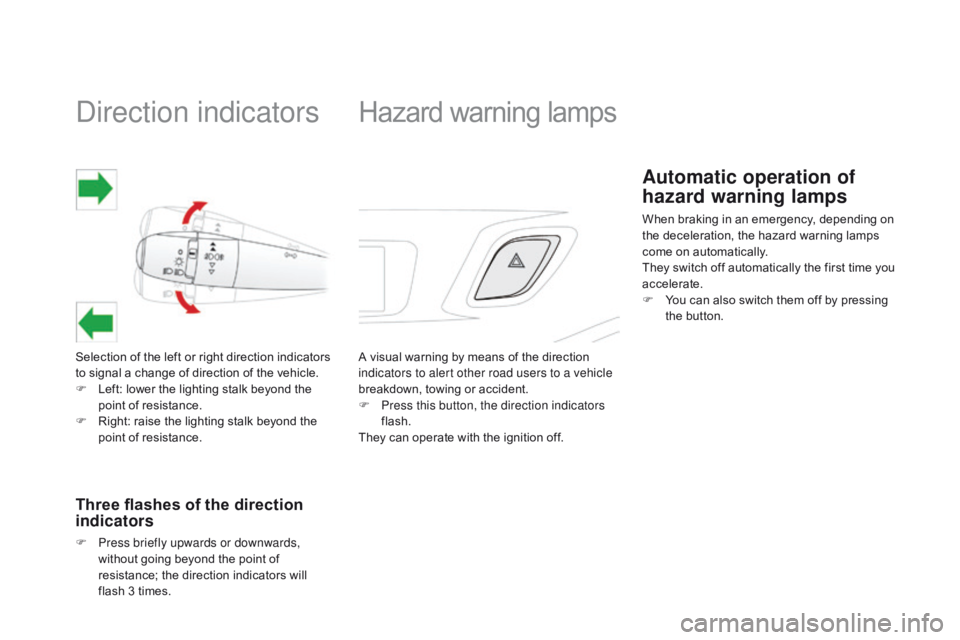
Direction indicators
Selection of the left or right direction indicators to signal a change of direction of the vehicle.
F
L
eft: lower the lighting stalk beyond the
p
oint of resistance.
F
R
ight: raise the lighting stalk beyond the
p
oint of resistance.
Three flashes of the direction
indicators
F Press briefly upwards or downwards, without going beyond the point of
r
esistance; the direction indicators will
f
lash 3 times.
Hazard warning lam ps
A visual warning by means of the direction i
ndicators to alert other road users to a vehicle
breakdown,
towing or accident.
F
P
ress this button, the direction indicators
flash.
They
can operate with the ignition off.
Automatic operation of
hazard warning lamps
When braking in an emergency, depending on the deceleration, the hazard warning lamps
c
ome on automatically.
They
switch off automatically the first time you
a
ccelerate.
F
Y
ou can also switch them off by pressing
t
he button.
Page 163 of 404

161
DS3_en_Chap08_securite_ed01-2014
Operating faults
In the event of an impact to the windscreen at the sensor, deactivate
the
system and contact a CITROËN
d
ealer or a qualified workshop to have
y
our windscreen replaced.
Never
try to remove, adjust or test
t
he sensor.
on
ly a CITR
oË
N dealer or a qualified
workshop
is able to work on the system.
When
towing a trailer or when the
v
ehicle is being towed, the system must
b
e deactivated.
Do not stick or other wise fix any object on the windscreen in front of the sensor.
Sensor fault
The operation of the laser sensor may suffer inter ference from accumulations of dirt or
m
isting of the windscreen. In this case you are
w
arned by the display of a message.
Use
the windscreen demisting and regularly
c
lean the area of the windscreen in front of the
sensor.
System fault
In the event of a malfunction of the system, you a re warned by an audible signal and the display
o
f the message "Automatic braking system
fault" .
Have
the system checked by a CITROËN
d
ealer or a qualified workshop.
Safety
Page 190 of 404
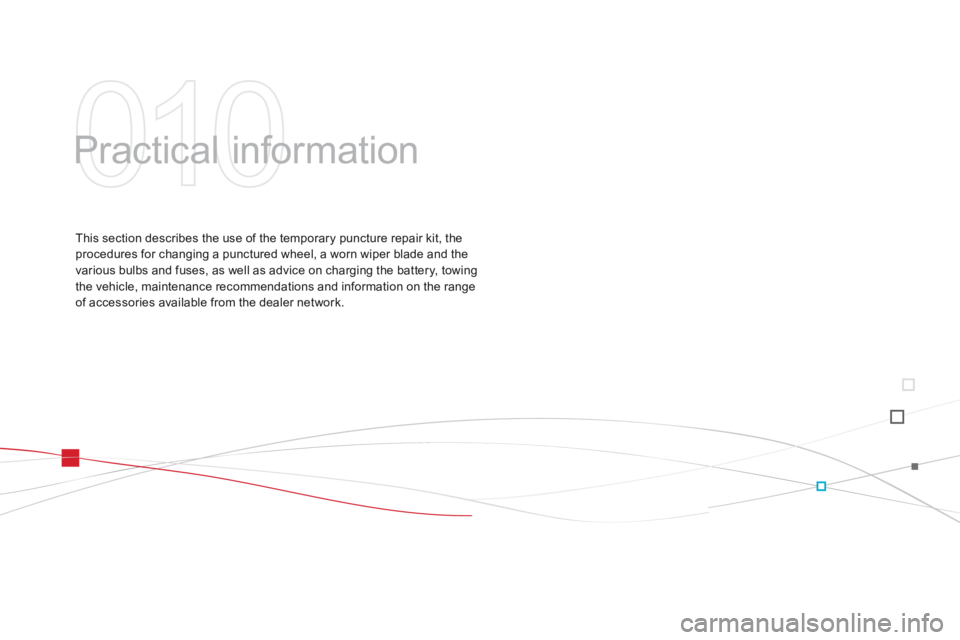
DS3_en_Chap10_info-pratiques_ed01-2014
Practical information
This section describes the use of the temporary puncture repair kit, the procedures for changing a punctured wheel, a worn wiper blade and the
v
arious bulbs and fuses, as well as advice on charging the battery, towing
t
he vehicle, maintenance recommendations and information on the range
o
f accessories available from the dealer network.
Page 238 of 404
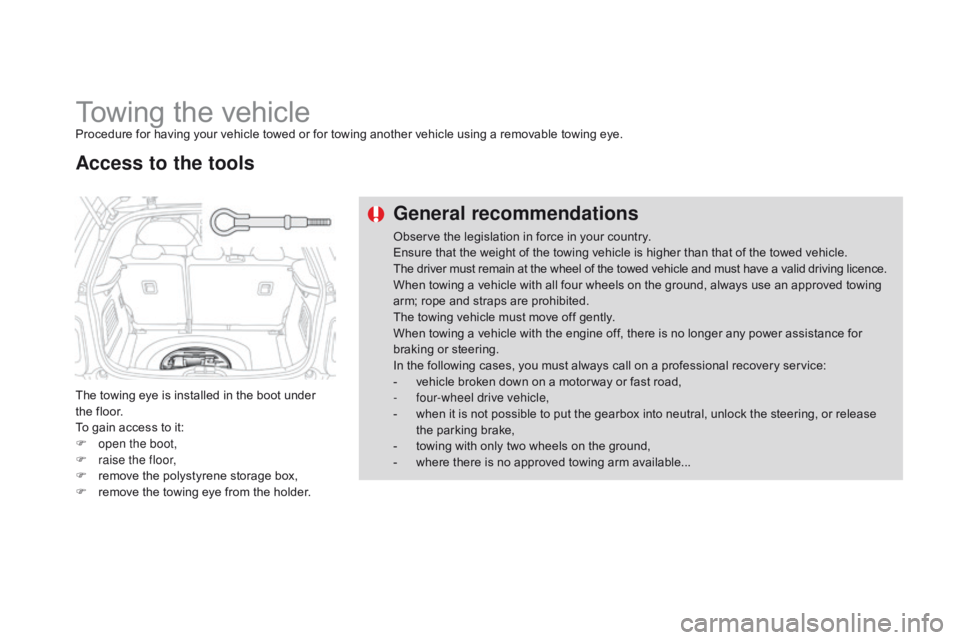
DS3_en_Chap10_info-pratiques_ed01-2014
Towing the vehicleProcedure for having your vehicle towed or for towing another vehicle using a removable towing eye.
T he towing eye is installed in the boot under
t
he floor.
To
gain access to it:
F
o
pen the boot,
F
r
aise the floor,
F
r
emove the polystyrene storage box,
F
r
emove the towing eye from the holder.
Access to the tools General recommendations
Observe the legislation in force in your country.
E nsure that the weight of the towing vehicle is higher than that of the towed vehicle.
The
driver must remain at the wheel of the towed vehicle and must have a valid driving licence.
When
towing a vehicle with all four wheels on the ground, always use an approved towing
a
rm; rope and straps are prohibited.
The
towing vehicle must move off gently.
When
towing a vehicle with the engine off, there is no longer any power assistance for
b
raking or steering.
In
the following cases, you must always call on a professional recovery service:
-
v
ehicle broken down on a motor way or fast road,
-
f
our-wheel drive vehicle,
-
w
hen it is not possible to put the gearbox into neutral, unlock the steering, or release
t
he parking brake,
-
t
owing with only two wheels on the ground,
-
w
here there is no approved towing arm available...
Page 239 of 404
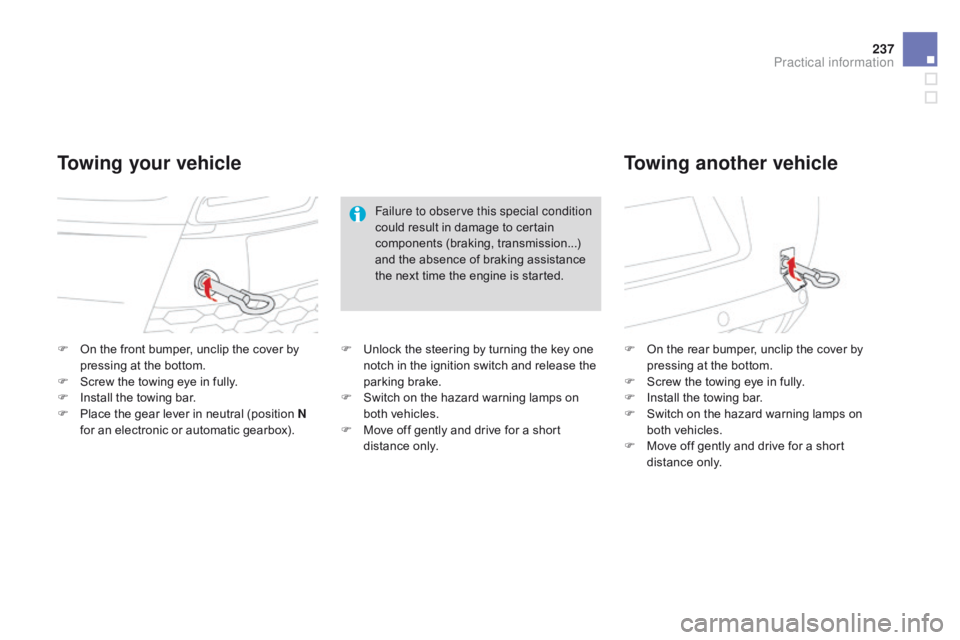
237
DS3_en_Chap10_info-pratiques_ed01-2014
F On the front bumper, unclip the cover by p
ressing at the bottom.
F
S
crew the towing eye in fully.
F
I
nstall the towing bar.
F
P
lace the gear lever in neutral (position N
for
an electronic or automatic gearbox). F
O n the rear bumper, unclip the cover by p
ressing at the bottom.
F
S
crew the towing eye in fully.
F
I
nstall the towing bar.
F
S
witch on the hazard warning lamps on
b
oth vehicles.
F
M
ove off gently and drive for a short
d
istance
o
nly.
Towing your vehicleTowing another vehicle
Failure to observe this special condition
could
result in damage to certain
c
omponents (braking, transmission...)
a
nd the absence of braking assistance
t
he next time the engine is started.
F
U
nlock the steering by turning the key one
n
otch in the ignition switch and release the
par
king
b
rake.
F
S
witch on the hazard warning lamps on
b
oth vehicles.
F
M
ove off gently and drive for a short
d
istance
o
nly.
Practical information
Page 240 of 404

DS3_en_Chap10_info-pratiques_ed01-2014
Towing a trailer
Towbar suitable for the attachment of a trailer with a dditional l ighting an d s ignalling. We
recommend the use of genuine
C
ITR
oË
N towbars and their harnesses
that have been tested and approved
from the design stage of your vehicle,
a
nd that the fitting of the towbar is
e
ntrusted to a CITR
oË
N dealer or a
qualified
w
orkshop.
If the towbar is not fitted by a CITR
oË
N
dealer, it is imperative that it is
f
itted in accordance with the vehicle
manufacturer's
i
nstructions.
Driving with a trailer places greater demands
o
n the towing vehicle and the driver must take
par
ticular
c
are.
driving advice
distribution of loads
F Distribute the load in the trailer so that the heaviest items are as close as possible to t
he axle and the nose weight approaches the
m
aximum permitted without exceeding it.
ai
r density decreases with altitude, thus
reducing
engine per formance. Above
1
000 metres, the maximum towed load must
b
e reduced by 10 % for every 1 000 metres of
al
titude.
Side wind
F Take into account the increased sensitivity t
o side wind.
Your
vehicle
is
primarily
designed
for
t
ransporting
people
and
luggage,
but
it
may
a
lso
be
used
for
towing
a
trailer. Refer to the "Technical Data" section for details
of the weights and towed loads which apply to
y
our vehicle.
Page 241 of 404
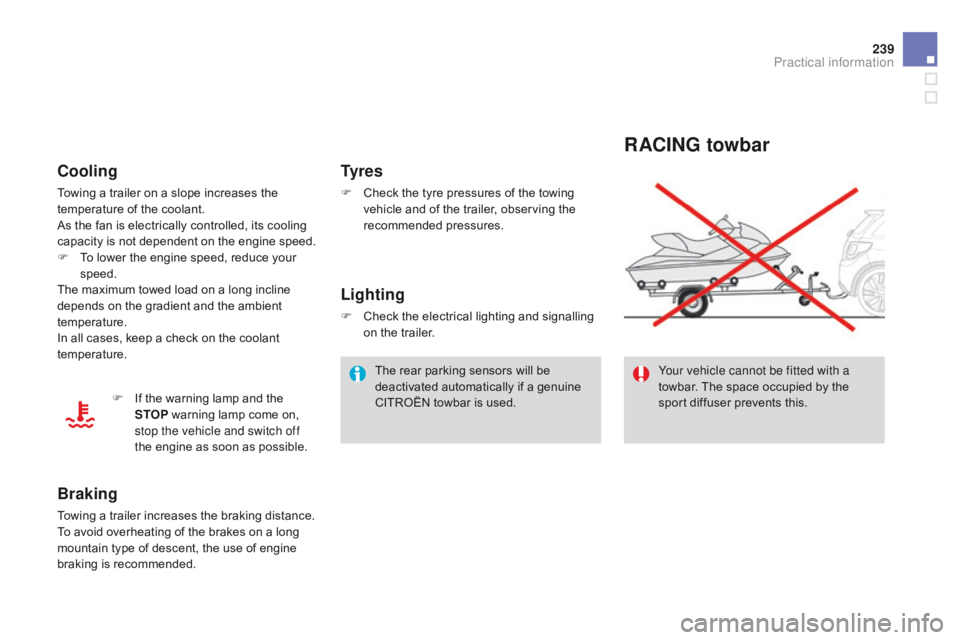
239
DS3_en_Chap10_info-pratiques_ed01-2014
RAcING towbar
Your vehicle cannot be fitted with a
towbar. The space occupied by the
s
port diffuser prevents this.
Ty r e s
F Check the tyre pressures of the towing v
ehicle and of the trailer, observing the
re
commended
p
ressures.
cooling
Towing a trailer on a slope increases the temperature of the coolant.
As
the fan is electrically controlled, its cooling
c
apacity is not dependent on the engine speed.
F
T
o lower the engine speed, reduce your
s
peed.
The
maximum towed load on a long incline
d
epends on the gradient and the ambient
t
emperature.
In
all cases, keep a check on the coolant
t
emperature.
Braking
Towing a trailer increases the braking distance.
T o avoid overheating of the brakes on a long
m
ountain type of descent, the use of engine
b
raking is recommended.
Lighting
F Check the electrical lighting and signalling o
n the trailer.
The
rear parking sensors will be
d
eactivated automatically if a genuine
C
ITROËN towbar is used.
F
I
f
the
warning
lamp
and
the
S
TOP
warning
lamp
come
on,
s
top the vehicle and switch off
the
engine
as
soon
as
possible.
Practical information